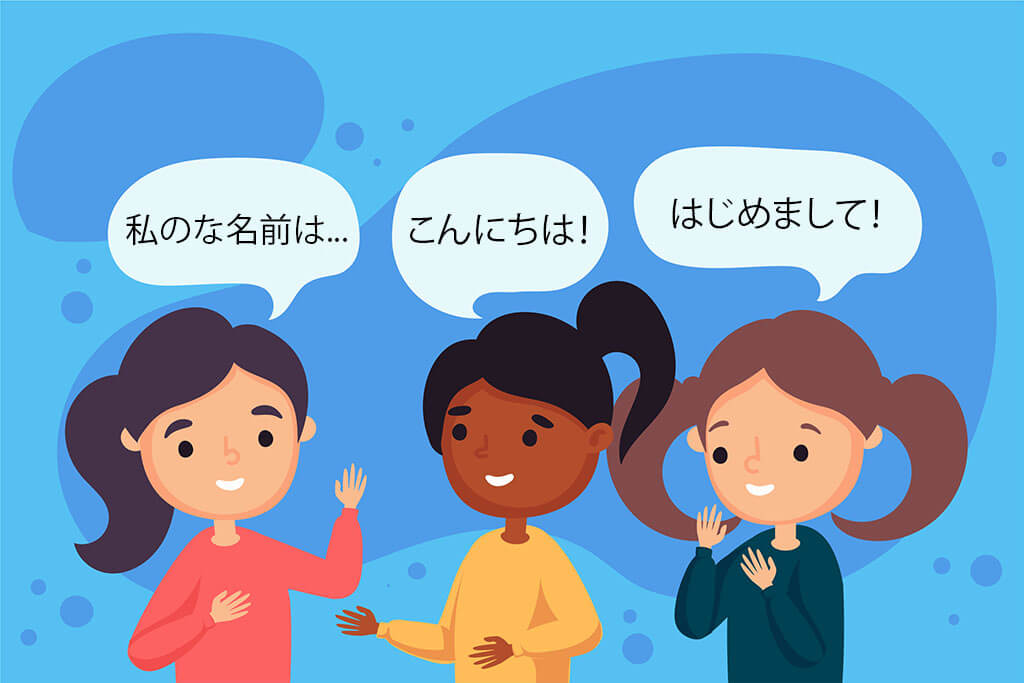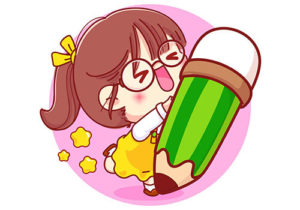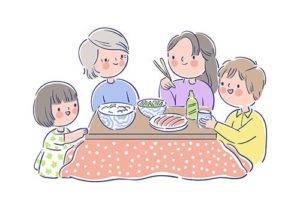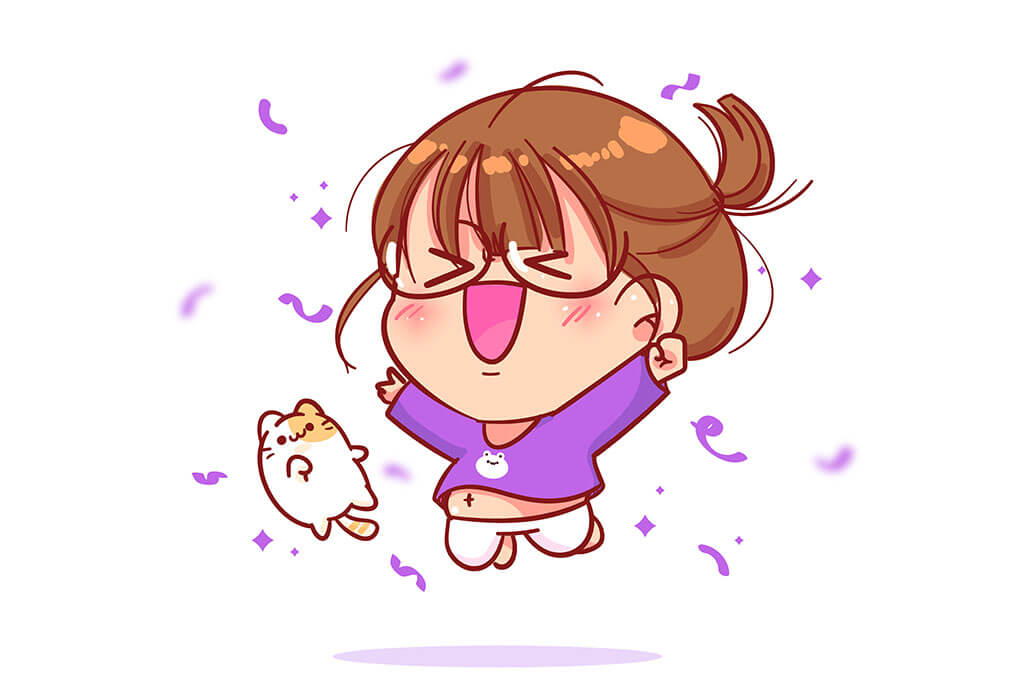How to say My Name Is in Japanese: #1 Ultimate Guide
Japanese textbooks typically teach the following two phrases as the standard way to say “my name is” in Japanese.
- 私の名前は [name]です。
watashi no namae wa [name] desu.
My name is [name].
- 私は [name] です。
watashi wa [name] desu.
I am [name].
However, although these ways of introducing yourself are correct, there are more natural expressions that you can use.
With that said, the easiest and most common way to tell someone what your name is in Japanese is to simply state your name and attach です (desu). For example:
- [name] です。
[name] desu.
I’m [name].
At the same time, there are a plethora of expressions that you can use to tell someone your name in Japanese outside of using です (desu).
As politeness and formalities are crucial in Japanese, it’s important to know the nuances of each expression.
This ultimate guide is tailored for beginners and intermediate learners alike. Entries are coupled with audio for your pronunciation reference.
Easiest Way to say “My name is…” in Japanese
As mentioned, the simplest and most widely used expression to introduce your name in Japanese is to use the following expression:
- I’m [name].
[name]です。
[name] desu.
Simply say your name and attach です (desu), which is the equivalent of saying “I’m [name]” in Japanese.
Pronunciation for です (desu):
The word です (desu) is a formal Japanese linking verb that means “to be” in English. You may have also noticed the lack of pronouns in this sentence. This is because you often omit pronouns in speech as it sounds considerably more natural.
Therefore, simply stating your name and following it with です (desu) is sufficient enough to convey the meaning of “my name is [name]” in Japanese.
Even though you can apply more levels of formality to your speech, (more on that later), employing です (desu) in your speech is an excellent means to assure adequate politeness.
Hence, this expression is a general way to introduce your name to anyone, without stressing about formalities too much. It is a very natural and common way to say “my name is” in Japanese.
When introducing your full name in Japanese, you say your surname first, followed by your first name.
For example, if your name was Harry Potter, you would say:
- ポッター・ハリーです。
Potta ・ hari- desu.
I’m Harry Potter.
It’s also interesting that for non-Japanese names, a ・ is used to separate the surname and first name instead of a space.
Saying “Nice to meet you, my name is” in Japanese
- Nice to meet you, my name is [name].
はじめまして。[name]です。
hajimemashite. [name] desu.
When you meet someone for the first time, you may want to say はじめまして (hajimemashite), before telling them your name.
はじめまして (hajimemashite) is the way to say “it’s nice to meet you” in Japanese. it is as simple as using a single word!
The word はじめまして (hajimemashite) originates from the verb はじめて (hajimete), meaning “first time” in Japanese. With that said, はじめまして (hajimemashite) is a great word to use when you want to show politeness to someone whom you’re just meeting for the first time.
After you’ve said はじめまして (hajimemashite), follow up with your name before finishing withです (desu) to tell someone “nice to meet you, my name is…” in Japanese.
Recommended: How to say Nice to Meet You in Japanese [Ultimate Guide].
“I am…” in Japanese
- I am [name].
私は [name] です。
watashi wa [name] desu.
Textbooks and other learning resources may teach you to use the above expression to tell someone your name.
The main difference with this entry compared to the one before it is the inclusion of 私は (watashi wa). This preceding 私は (watashi wa) translates as “I am” in Japanese. Unlike in English, however, removing pronouns helps your speech sound much more natural.
For this reason, it’s a good idea to reduce the frequency of 私は (watashi wa) in your speech.
Many learning resources may include 私は (watashi wa) in examples sentences as a means to help you remember the meaning. However, because the word appears in so many resources, you’ll soon find that you’ve retained it without having to drill it into your head.
It’s not that using 私は (watashi wa) in your speech is grammatically incorrect, it’s just that it comes across as repetitive.
私は[name] です。
watashi wa[name] desu.
I amI’m [name].
Therefore, simply saying your name plus です (desu) is the easiest and most common method to use.
“Hello, my name is” in Japanese
- Hello, I’m [name].
こんにちは。[name] です。
konnichi wa. [name] desu.
The standard way to include a greeting in your introduction and say “hello, my name is [name] in Japanese is it use こんにちは (konnichi wa).
こんにちは (konnichi wa), as you may have heard, is a common way to say “hello” in Japanese. Generally, you can also use it to say “good day” or “good afternoon” as well.
Those of you who are more familiar with the language may be aware that the final は (ha) is actually pronounced as (wa). See the audio for native pronunciation reference!
The reason for this originates from the seldom-used kanji for the greeting. In kanji, こんにちは (konnnichi ha) is written as 今日は (konnnichi ha). 今 means “now” and 日 is the kanji for “day”.
Combined they make 今日 (kyou), the word for “today” in Japanese. The は (ha) is actually a grammar particle that is typically pronounced as (wa) when used as one.
The modern こんにちは (konnichi wa) is a condensed form of the traditional greeting, 今日は (kyou wa).
It stems from typical greetings such as those that refer to the weather, such as 今日は暑いですね! (kyou ha atsui desu ne!).
Stating your name and following it with です (desu) after saying こんにちは (konnichi wa) is an excellent way to say “hello, my name is…” in Japanese!
Suggested: How to say Have a Good Day in Japanese [Ultimate Guide].
“Please Call Me…” in Japanese
- Please call me [name].
[name]と呼んでください。
[name] to yonde kudasai.
After you’ve told someone your name using one of the above expressions, you may wish to inform them of an alias, nickname, or another name that you’d prefer to be called by.
You can specify how you’d like to be called using the above phrase. Simply insert your prefered way to be addressed into the [name] section, and you’re good to go.
Just like in English, you will typically use this phrase immediately after telling someone your given name.
For example, first, you begin with your introduction.
- 初めまして。マイケルです。
hajimemashite. maikeru desu.
Nice to meet you. I’m Michael.
Secondly, you introduce your preferred way of being called:
- マイクと呼んでください。
maiku to yonde kudasai.
Please call me Mike.
This phrase uses a conjugated form of the verb 呼ぶ (yobu), meaning “to be called” in Japanese. 呼ぶ (yobu) is conjugated into the te-form, which, in this case, transforms the sentence into a request.
Conjugating 呼ぶ (yobu) into the te-form makes it 呼んで (yonde).
Located at the end of the phrase is ください (kudasai) which means “please” in Japanese.
Therefore, when you use this phrase, you request that the person addresses you by a certain name.
Suggested: How to say Thank You in Japanese [Ultimate Guide].
Direct Japanese Translation of “My name is”
- My name is [name].
私の名前は [name] です。
watashi no namae ha [name] desu.
You may also see the above expression listed in Japanese textbooks.
We’ve established that 私 (watashi) is the pronoun for “I” in Japanese. Following the 私 (watashi) is の (no), a Japanese grammar particle that connects two nouns together.
Although it has many uses, its general function is to indicate possession of the preceding noun.
For instance, the word for “today” in Japanese is 今日 (kyou). Attaching the particle の (no) to the word would make it: 今日の (kyou no), meaning “today‘s” indicating that “today” is in possession of something.
Add the word for “weather“, being 天気 (tenki) and you can make the sentence:
- 今日の天気はいい。
kyou no tenki ha ii.
Today‘s weather is good.
With this in mind, combining the の (no) particle with 私 (watashi) makes 私の (watashi no), meaning “my” in Japanese.
Suggested: How to say Good in Japanese [Ultimate Guide]
The next part of this expression is 名前 (namae), the word for “name” in Japanese. This word just so happens to be similar to the English word in terms of pronunciation, making it easy to remember!
Following this is は (ha), another particle that marks the preceding noun as the subject of the sentence. In the case of 私の名前は [name] です (watashi no namae ha [name] desu), emphasis is on the word “name” as the subject.
Like the previous entry, this method of telling someone your name is also not very common.
People typically choose the easier alternative of simply saying “I’m [name]” rather than dragging it out by saying “my name is [name].”
With that said, this is still a method you’ll see in textbooks and may hear used when speaking with children, for example.
Asking “What Is Your Name?” in Japanese
- What is your name?
お名前は何ですか。
onamae ha nan desuka?
The standard way to ask someone for their name in Japanese is to use the above expression.
When introducing your own name to someone, it’s natural to omit pronouns, and the same is true when asking for someone’s name.
Therefore, when asking for someone’s name in Japanese, you don’t need to address them as “your”. Let’s break down the expression!
- お名前 (onamae) is made up of two parts. The latter 名前 (namae) is the word for “name” in Japanese. The preceding お (o) acts as a kind of word-beautifier that transforms the following noun into a more respectful and polite word.
- You could drop the お (o) and simply use 名前 (namae). It just sounds a little less polite. Whether you use 名前 (namae) or お名前 (onamae) is up to you. Although I recommend using the former!
- Appearing next is は (ha), a Japanese grammar particle that marks the preceding noun as the subject of the sentence.
- 何ですか (nan desuka) is a polite way of saying “what is?” in Japanese. You may have noticed the lack of a question mark on the Japanese text. This is because the ending か (ka) functions similarly to the question mark!
An easier way to understand this expression is to read it backwards. In doing so, we can understand it as literally”what is (your) name?”.
An even easier way to ask someone “what is your name” in Japanese is to use:
- お名前は?
onamae ha.
Your name is…?
It’s perfectly natural to drop the last part of the original expression and simply ask お名前は (onamae ha). If you do decide to opt for this method, be sure to not drop the お (o) before 名前 (namae) as it can come across as quite blunt!
Asking “Could You Tell Me Your Name?” in Japanese
- Could you tell me your name?
お名前を教えてもらえますか。
onamae wo oshiete moraemasuka.
Although the above expression is considerably longer than the others, it’s the most natural way to ask someone if they could tell you their name in Japanese.
お名前 (oaname), the word for “name” in Japanese, is followed by を (wo), a grammar particle that designates the preceding noun as the object of the following verb.
The subsequent verb conjugation, 教えてもらえますか (oshiete moraemasu ka) is the Japanese phrase for “could you tell me”.
Similar to the previous entries, you don’t need to include any pronouns for this expression either!
The nature of this phrase is that it indicates that someone is doing you a kind of favour by telling you their name.
Therefore, when you need to be a little humble, you should use this phrase.
As an example, an interviewer may ask another if they could tell them their name using this phrase. The reason for this is that it sounds more polite than simply asking “what is your name?” directly.
Asking “What Was Your Name Again?” in Japanese
When you don’t know, or worse, have forgotten someone’s name in Japanese speech, the conversation can become extremely challenging.
This is because the most common way to say “you” in Japanese, is not to use the pronoun but to refer to the person by their name, even if you’re speaking with them directly.
This took some time to get used to as a beginner, yet, in basic terms, every time you refer to someone as “you” in Japanese, use their name. This is the most common and natural way to speak to someone.
For this reason, remembering names in Japanese is extremely important.
If you don’t know or don’t remember their name, you’ll be having a conversation without using the word “you”. It’s very difficult and it does become obvious that you’ve forgotten their name.
Therefore I recommend asking the person as soon as possible to remind you of their name. There are plenty of ways you can do this, and here’s how!
Suggested: I Don’t Know in Japanese [Ultimate Guide].
Asking Them Directly
- Sorry. Could you tell me your name once more?
すみません。もう一度お名前を教えてもらえますか。
sumimasen mou ichidou onamae wo oshiete moraemasu ka.
The first method is to ask them directly. This is a very polite expression that you can use when you have forgotten someone’s name and wish to be reminded.
You can opt to begin with an apology by saying すみません (sumimasen). This is a respectful word that means “sorry” or “excuse me” in Japanese.
The main expression begins with もう一度 (mou ichidou), which means “once again”, or “once more”.
We’ve established that お名前 (onamae) is the polite word for “name” in Japanese.
This is followed by を (wo) which is another grammar particle that marks the preceding noun as the object of the following verb or action.
The final and longest section is 教えてもらえますか (oshiete moraemasu ka).
It begins with 教えて (oshiete), the te-form of the verb 教える (oshieru) meaning “to teach” or “to tell”.
One of the functions of the te-form is to link verbs together to extend the length of a sentence.
教えて (oshiete) connects to もらえます (moremasu), the potential form of the verb もらいます (moraimasu), meaning “to receive”.
Verbs in the potential form express the capability of being able to do an action. Essentially, this means that the potential form of “receive” is “can receive”.
Lastly, the か (ka) marks the entire sentence as a question. When か (ka) is present, question marks are not needed!
In summary, this expression asks if it’s possible to receive certain information once again, with that information being the person’s name.
For this reason, The inclusion of もらいます (moraimasu) makes the phrase humbling.
Thus it’s a formal and respectful phrase you can use when you wish to ask someone directly if they could remind you of their name!
Asking Another for Another’s Name
- Who was that person just now?
さっきの人は誰なんですか?
sakki no hito ha dare nandesu ka.
Another way to discover a person’s name is to ask someone who has just spoken with them.
Using the above phrase, you can ask “who was that person just now” to someone else.
It goes without saying that you can only use this phrase to communicate naturally after someone has just finished interacting with the individual whose name you would like to find out.
The first word of this phrase is さっき (sakki), which refers to a moment in time that has just happened. Essentially, さっき (sakki) means “just now” or “a moment ago”.
Following さっき (sakki) is の (no), the possessive grammar particle. You use の (no) to indicate the possession of the following noun by the preceding one. The subsequent noun is 人 (hito), which means “person” in Japanese.
Therefore, we can understand the phrase さっきの人 (sakki no hito) to mean “the person of just now“.
は (ha) is another particle that marks the prior noun as the subject of the sentence.
Finally, 誰なんですか (dare desu ka) is made of two parts. The first is 誰 (dare), which means “who” in Japanese. なんですか (nan desu ka) functions as the part that transforms the sentence into a question.
I Have Completely Forgotten Your Name
- I’ve completely forgotten your name, what was it?
名前を忘れちゃったんだけど、なんだっけ?
namae wo wasurechattandakedo, nanndake?
The above phrase is a very casual way of telling someone directly that you have absolutely no memory of their name. You’ve completely forgotten it and are asking for it again.
As this phrase is best reserved strictly for casual speech, be careful with who you use it with.
It’s worth noting that this phrase also lacks any pronouns. As such, you can use this phrase as-is to ask someone what their name is or to ask someone else what the name of someone else is.
The reason why you will be able to comprehend what this question is specifically asking, depends on the context of the prior conversation.
Let’s say you were having a talk about the Harry Potter series. You’re talking about the main antagonist of the series, but you’ve forgotten their name.
In this case, if you were to use the above phrase, you’d be saying “I’ve completely forgotten their name, what was it again?” rather than “I’ve forgotten your name…”.
Suggested: How to say Or in Japanese [Ultimate Guide]
The Best Way to say “My name is” in Japanese
- My name is [name].
[name]と言います。
[name] to iimasu.
As you’ll likely have just met the person for the first time, you will need to speak politely when you introduce your name to them. This is because there are many levels of honorifics in Japanese.
Which honorific you should use, depends on the situation and whom you’re speaking with.
When introducing yourself to a classmate, for instance, you could use slightly less formal speech.
Since it’s likely you are of the same age, and are of the same social status as “classmates”, lessening the extent of your formality during your greetings is a common thing to do.
On the other hand, you would be expected to speak much more humbly when speaking to a hiring manager, for instance.
The expression [NAME]と言います ([name] to iimasu) is a safe option to choose from when deciding on how you want to tell someone what your name is in Japanese.
Just like stating your name and attaching です (desu) is a great means to introduce yourself, this expression can be an excellent alternative.
The と言います (to iimasu) is a formalised version of the verb 言う (iu), which means “to say” or “to be called”.
Hence, when you tell someone your name using this expression, you’re essentially telling them “I’m called [name]”, which is a very natural way to introduce yourself in Japanese.
By saying your name followed by と言います (to iimasu), you’re communicating with a reasonable level of politeness.
With that said, there be some occasions where you may wish to increase formalities higher.
Telling Your Name in Formal Japanese
- My name is [name].
[name]と申します。
[name] to moushimasu.
The most polite and formal way you can tell someone your name in Japanese is to use the above expression.
During business scenarios, interviews or meetings etc you will need to apply the highest formality possible to your speech.
For instance, during your self-introduction at an interview for a job, you should introduce yourself with と申します (to moushimasu).
It’s also important to remember that when introducing your full name in Japanese, you should say your surname first, then your first name.
The 申します (moushimasu) is the kenjougo, or humble version of the 言います (iimasu), which we looked at in the above entry.
This means that 申します (moushimasu) is just an even more formal way of introducing your name with 言います (iimasu).
How Are You in Japanese
As introducing your name to someone is typically a part of a greeting, you may wish to ask the person how they are doing too.
However, in Japanese, asking someone how they are doing is typically only done when you talk to someone for the first time in a while.
Therefore, asking someone how they are in Japanese is not something you’d really see to someone you saw just yesterday.
With that said, there are alternative expressions and phrases that you can use.
I’ve composed an extensive list in this ultimate guide that details how to say “how are you in Japanese.”
Asking “Should I Write My Name Here?” in Japanese
- Shall I write my name here?
ここに名前を書きますか。
koko ni namae wo kakimasu ka.
This is a particularly useful phrase to know when filling out forms in Japanese.
Many places in Japan prefer to use paper forms and paper documents, rather than digital ones.
For this reason, you’ll definitely be asked to write your name down a good few times.
But, what if you’re not sure where to write your name… as the form is in Japanese?
To confirm the location you can use one of two phrases. The first is the above phrase, which you can use to verify that you are going to write your name in the correct place.
The second phrase to use is:
- どこに名前を書きますか。
doko ni namae wo kakimasu ka.
Where shall I write my name?
Use this phrase to ask where you should write your name when you’re completely unsure.
To clarify for anyone wondering, you do not need to use お名前 (onamae) in place of 名前 (namae) here.
This is because お名前 (onamae) should only be used when talking about someone else’s names. When you’re talking about your own name, omit the お (o), and use 名前 (namae).
Surname/Family Name in Japanese
The word for “surname” in Japanese is 名字 (myouji).
It is made up of two kanji, 名 which means “name” and 字, meaning “character”.
You could use it to ask questions such as:
- 名字は何ですか。
myouji ha nandesu ka.
What is your surname?
- 名字の綴りは?
myouji no tsutzuri ha?
How do you spell your surname?
How to say Your Actual Name in Japanese
You may be wondering how your name is written and sounds in the Japanese language. While traditional Japanese-style names contain kanji, foreign names are typically rendered in katakana.
Katakana is one of the three scripts in the Japanese alphabet. It is used primarily for words of foreign origin. Therefore, there are plenty of words that may initially sound similar to English, however, they are phonetically different. To learn more about what katakana is, refer to this ultimate guide.
For instance, my name is Aaron. Rendering it in katakana looks like this: アーロン. Use the audio below for a native pronunciation reference.
It’s also important to know that you don’t write foreign names in hiragana. It is always katakana.
So, how do you say your name in Japanese? Enter your name in this resource to see how it looks in written Japanese!
Take a look at the complete collection of ultimate how-to Japanese guides here!
How to say My Name Is in Japanese: #1 Ultimate Guide Read More »































































